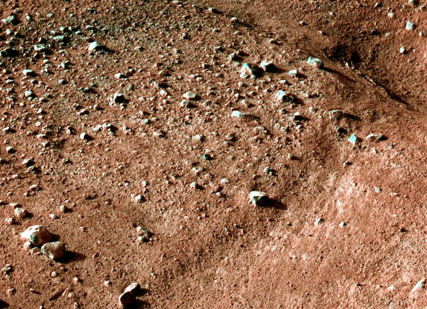Mars Orbiter develops minor glitch - takes stunning photograph of Phoenix Lander
28 May 2008
 Pasadena, Calif: In what appears to be a minor glitch, NASA's Mars Reconnaissance Orbiter (MRO), the spacecraft currently orbiting Mars, hit a snag as the radio with which it communicates with the Phoenix Mars Lander on the surface of the red planet, shut itself off due to an unidentified problem, NASA scientists said. However, a remarkable photograph of the Phoenix Mars Lander, parked on the surface of the planet along with its parachute and heat shield, came as a pleasant surprise for the scientists at the JPL, Pasadena facility.
Pasadena, Calif: In what appears to be a minor glitch, NASA's Mars Reconnaissance Orbiter (MRO), the spacecraft currently orbiting Mars, hit a snag as the radio with which it communicates with the Phoenix Mars Lander on the surface of the red planet, shut itself off due to an unidentified problem, NASA scientists said. However, a remarkable photograph of the Phoenix Mars Lander, parked on the surface of the planet along with its parachute and heat shield, came as a pleasant surprise for the scientists at the JPL, Pasadena facility.
The glitch appears to have left the scientists unfazed, who stressed that the Phoenix appeared to be doing just fine. "Phoenix is healthy, everything is fine," said Fuk Li, manager of the Mars Exploration Laboratory at NASA's Jet Propulsion Laboratory (JPL).
The radio shutdown prevented mission scientists from sending Phoenix its instructions for the day, as well as from receiving another set of images from the lander. MRO controllers said they are working on the problem and hope to have it fixed for the next scheduled link-up.
If the problem is resolved, then mission scientists will attempt to move the lander's robotic arm today. Once this is achieved scientists will start practicing scooping up soil and in about a week, they may start placing their first samples on the Lander's scientific instruments.
Phoenix made an arrested landing in the north polar regions of Mars in the Vastitas Borealis plains on Sunday. If all goes well the Lander's robotic arm will dig down to the rock-hard layers of water ice presumed to lie under the Martian soil near the planet's north pole. The soil and ice will be tested for signs that the water was once liquid and that it could have created a habitable zone for microbial life at some point of time.
Meanwhile, the orbiting MRO's HiRISE camera took a stunning photograph on Monday that showed Phoenix, with its fan-like solar arrays visible. The image also showed two black spots that may be the jettisoned heat shield along with a bounce mark that it may have made. Th photograph also showed the lander's parachute, which appears as a white smudge about 300 meters away from the lander.

"We're thrilled with these images," said HiRISE principal investigator Alfred McEwen of the University of Arizona. HiRISE will likely take more images of the lander and the surrounding terrain throughout the mission.
Phoenix also sent back more images yesterday, including one of its robotic arm, which showed that the biobarrier that protected it during its flight had more fully deployed since the previous day. The lander also took more images of the landing site terrain, this time to the south of the lander showing a series of low hills about 5.5 miles (9 kilometers) away. The clarity of the image indicated clear skies on Mars. "That means that there's not much dust in the atmosphere; it's a very clear day," said Phoenix principal investigator Peter Smith, also of the University of Arizona.
 By now scientists have also been able to more accurately pinpoint Phoenix's landing spot. New estimates of the lander's position shows that "we really landed in the spot the scientists were looking for," said JPL Navigation team chief, Brian Portock.
By now scientists have also been able to more accurately pinpoint Phoenix's landing spot. New estimates of the lander's position shows that "we really landed in the spot the scientists were looking for," said JPL Navigation team chief, Brian Portock.
The landing spot still looks largely devoid of rocks, which is perfect for digging, Smith said. "All of this is prime digging area," he said.
Though the MRO radio glitch has delayed Phoenix's schedule by a day, mission scientists said the Phoenix has a default set of instructions, which it will follow if it fails to receive any new commands in the morning.













.jpg)






.jpg)









